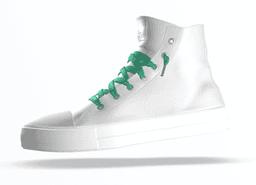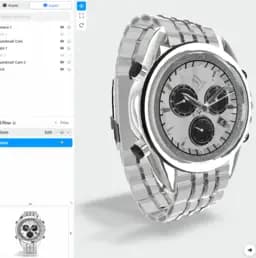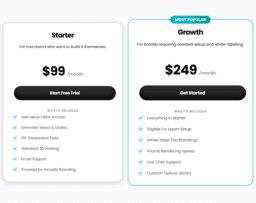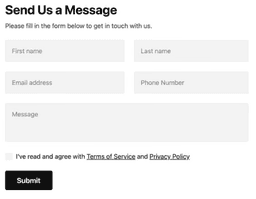How to Optimize Augmented Reality Performance for the Web
Performance optimization for Web AR involves prioritizing performance enhancements, optimizing 3D models, and streamlining AR development. Techniques like leveraging WebXR API, efficient optimization of 3D assets, minimizing network requests, continuous performance testing, and adhering to accessibility and usability guidelines play a pivotal role.

In this guide, readers will gain an understanding on how to effectively boost Web AR performance and overcome the common issues encountered during the optimization processes.
Leveraging the Power of WebXR API
Web extended reality (WebXR), an open standard for web-based AR experiences, is revolutionizing the real and digital worlds. WebXR API’s powerful features can notably amplify your AR web applications’ performance.
Enhanced Performance
WebXR API provides a suite of rich features that play a vital role in AR applications. As a developer, understanding these could significantly impact the performance of your applications.
Comprehensive Cross-Platform Support
The inclusive approach of the WebXR API offers consistent support across platforms, allowing developers to create immersive AR experiences on the web. Its wide-ranging support fosters the rendering of 3D scenes, seamless tracking of the user’s position, and adept management of input events – all critical facets of AR development.
Improving AR’s Native Performance and Functionality
With WebXR API at the core of development, reliance on third-party libraries or plugins diminishes significantly. By leveraging the API’s tools, developers can enhance native performance and functionality, thereby ensuring streamlined, optimal AR on the web.
- 3D Rendering: Superior rendering contributes to a more immersive AR experience. WebXR API ensures precise rendering of 3D scenes, taking the user experience to another level.
- Position Tracking: A crucial feature of any AR experience is position tracking. WebXR API provides accurate tracking of the user’s eye and device position, enabling more realistic object placement in AR.
- Input Management: The WebXR API enhances input event management capabilities, promising smoother interaction in AR environments.
One example worth mentioning is ‘XYZ AR App.’ Based entirely on WebXR API, the App exemplifies how API features can be leveraged for optimum performance. Their AR scenes load swiftly, interactions are fluid, and object placement is spot-on.
To get a better understanding of these features and how to implement them, this resource could be helpful: Tutorials for Effective Implementation of WebXR API in Web AR Applications.
Make the Most of WebXR API
To summarize, the intrinsic strength of the WebXR API is its ability to render enhanced performance. Providing expansive cross-platform support and improving native functionality, it can drive your AR application forward. Mastering these features could place you at the forefront of AR experiences on the web, boosting your application’s performance, user satisfaction, and ultimately, success.
Effective Optimization of 3D Assets
In the realm of Web AR development, 3D asset optimization plays a pivotal role in enhancing the performance of AR web applications. Owing to its significant effect on bandwidth, memory, and processing power usage, optimized 3D assets foster seamless and efficient user experiences. Moreover, these optimizations greatly impact the responsiveness and interactivity of Web AR interfaces, thereby improving the overall user engagement.
Understanding the Importance of 3D Asset Optimization

Asset optimization is paramount to limit resource consumption and ensure fast and fluid experiences in Web AR environments, effectively minimizing latency and asset loading times. Consider a real-world example where an e-commerce store uses Web AR to display furniture to prospective customers. If the 3D models of the furniture items are oversized or unnecessarily complex, the site could become slow and unresponsive, leading to reduced user interaction or even user abandonment. In contrast, optimization techniques can streamline these models to provide a better shopping experience.
Techniques for 3D Asset Optimization
- Reducing Asset Size and Complexity: Simplifying models by minimizing vertices and polygons, removing unnecessary details and downsampling textures can significantly reduce asset size without compromising on visual quality.
- Utilizing Compression Technology: Compression techniques like Draco for geometry and Basis Universal for textures can drastically shrink asset sizes while maintaining a high level of detail.
- On-Demand Loading: Loading assets only when needed helps keep initial load times low, improves responsiveness, and saves memory. This can be achieved via Level of Detail (LOD) techniques or simply not loading off-screen assets.
Web-friendly Formats
Choosing the appropriate asset format for the web is a blend of balancing the quality of assets with their file size. Web-friendly formats like glTF or USDZ have emerged as victories thanks to their on-demand loading abilities and widespread support. Utilizing such formats helps in further compressing assets without losing quality and consequently improving the overall Web AR application’s responsiveness and performance.
glTF vs USDZ
| Aspect | glTF | USDZ |
|---|---|---|
| Supported Platforms | Web, Android, iOS | iOS |
| File Size | Smaller | Larger |
| Animation Support | Keyframe/Skeletal | Keyframe only |
In essence, effective 3D asset optimization enables developers to create lighter, faster Web AR applications with wider user appeal, providing a seamless browsing experience for end-users. As a developer continues refining these skills, the pathway towards crafting highly optimized, responsive, and interactive Web AR experiences becomes clearer and achievable.

Minimizing Network Requests for Improved Performance
In the realm of Web AR, the performance of an application extensively hinges on the frequency of network requests. While it might seem inconsequential at first, the impact of network traffic on performance can be significant. The key to optimizing this lies in adopting a strategic approach to handle the network requests, especially in scenarios where latency and bandwidth are vital factors.
How Network Requests Affect Web AR User Experience
Every request channeled through the network is a potential snag in the seamless flow of User Experience (UX). Therefore, reducing the frequency of these network requests becomes paramount for enhancing the overall AR user experience. For instance, consider an AR application that allows users to visualize customized furniture in their living room. If it constantly makes network requests for each customization option, it becomes likely to cause delays, ultimately hampering the user experience.
Primarily, the frequency of network requests affect the following:
- The response time of your application.
- The amount of data transmitted across the network.
- The resulting round-trip time (RTT), particularly crucial for AR applications where real-time transmission and minimal latency are vital.
Techniques to Minimize Network Requests
Adopting several strategies can go a long way in minimizing network requests, thus boosting your Web AR application’s performance.
- Caching: This strategy stores a copy of resources that can be used for subsequent requests. This reduces the overall number of network requests and can help decrease latency.
- Bundling: Another effective technique is the bundling where several files are grouped into a single bundle. This helps reduce the number of requests.
- Prefetching: The prefetching technique involves loading resources before they’re needed, thus reducing loading times.
- Employing Service Workers: These act as a proxy between the browser and the network. Service workers are capable of intercepting network requests to deliver cached responses, leading to reduced RTT.
- Use of HTTP/2: Compared to HTTP/1, HTTP/2 makes fewer connections, resulting in fewer network requests and reduced latency.
| Technique | Brief Description | Impact on Network Requests |
|---|---|---|
| Caching | Stores a copy of resources for subsequent requests | Reduces overall network requests and decreases latency |
| Bundling | Groups several files into a single bundle | Minimizes the number of requests |
| Prefetching | Loads resources before they’re needed | Reduces loading times |
Learn more about optimizing your Web AR experiences by integrating analytics and tracking mechanisms by reading this informative guide on how analytics can help shape Web AR experiences.
Therefore, understanding the criticality of network requests and adopting these techniques can augment your Web AR application’s performance and deliver unmatched user experiences.
Inside the World of Continuous Performance Testing
To ensure consistent and high-performance functionality for Web AR applications, a detailed focus on continuous performance testing is crucial. This testing process underlines the significance of testing and measuring performance to enhance optimization efforts.

Importance of Varied Testing Conditions
The testing environment significantly shapes Web AR performance. Therefore, your app should be tested across various devices, browsers, and network conditions. For example, a Web AR app for virtual tours may perform seamlessly on a large screen with a stable internet connection while struggling on a mobile device in an area with low network coverage.
Essential Testing Metrics and Tools
Several performance metrics and tools can be used to measure the performance of your Web AR app. These parameters provide invaluable insights that help improve your application’s overall efficiency. Here are some of the essential metrics:
- WebXR Test API: It provides a straightforward way to validate the functionality of your Web XR sessions.
- Lighthouse: Gives your web app a performance score and provides suggestions for improvement.
- FPS(Frames Per Second): Measures the smoothness of the animations or interactions within your app.
- Web Vitals: Google’s initiative to provide unified guidance on quality signals essential to delivering a great user experience.
- RAIL: A user-centered performance model that provides a structure for thinking about performance.
| Tool | Use | Advantage |
|---|---|---|
| WebXR Test API | Test Web XR sessions | Eases functionality validation |
| Lighthouse | Evaluates web app performance | Provides improvement suggestions |
| RAIL | Performance analysis | User-centered approach |
Analyzing Performance Over Time
After deploying your Web AR application, it’s essential to keep track of its performance over time. Regular monitoring and analysis are key to identifying any rising issues and maintaining optimization. Tools like Google Analytics, Firebase, and Sentry can be used to track your app’s performance and gather data for analysis. These tools allow you to check how the app is being used and find bottlenecks that might be harming the performance.

Real-World Example of Performance Testing
When Snapchat rolled out their augmented reality filters, they initially encountered problems with performance. Their filters worked perfectly under optimal conditions, but when exposed to low-light environments, the filters failed to recognize features accurately. Through user feedback, Snapchat became aware of the problem and began a series of performance tests under various lighting situations. This continuous testing helped to improve the performance of AR filters exponentially over time, ensuring a consistent user experience.
Conclusion
To achieve a robust and efficient Web AR experience, embracing a culture of continuous performance testing is a must. Web AR needs varied environmental testing and ongoing performance monitoring to ensure optimum user experience irrespective of device, browser, or network condition.
The Role of Accessibility and Usability in Web AR
Web AR developers and UX designers aim towards immersive experiences in their projects. However, performance can hit roadblocks if we neglect the crucial aspects of accessibility and usability. Mastering these aspects aid developers in crafting AR applications that can be used and loved by everyone, irrespective of individual capabilities.

Unlocking AR Experiences for Everyone
Striving for accessibility and usability in AR applications ensures that all users, with all kinds of abilities, can successfully interact with these experiences. To illustrate this, let’s consider an example
Suppose an application is developed specifically for visually impaired users. An application focusing solely on aesthetic visuals wouldn’t serve the purpose. Thus, adding alternative audio content to communicate information, or haptic feedback for touch-based navigation, creates a more inclusive environment.
The result: Improved overall user satisfaction and reach.
Adhering to Essential Guidelines: Lists and Beyond
Following usability and accessibility guidelines during the design and development phase can work wonders for Web AR applications. These guidelines are more than prescribed rules; they are keys to unlocking flawless AR experiences.
Some of the pivotal guidelines include:
- Alternative content provision: Additional content forms ensure users can consume the information in a way most convenient for them.
- Keyboard and touch input support: Catering to varied user input types creates an inclusive environment.
- Averting motion sickness: Controlling motion dynamics can make the AR experience comfortable even for users prone to virtual reality sickness.
- Clear labels and tooltips: Explicit labels and instructions can guide users more effectively through the AR application.
These guidelines aim not only to streamline the user experience but also to arm developers with myriad possibilities to enhance their offerings.
Privacy and Consent: Cornerstones of Trust
Purity of intent is a vital characteristic to consider when you are delving into someone’s personal space with AR. Therefore, guidelines that advocate user privacy, data security, and explicit consent should be endorsed.
Developers wielding Web AR must ensure that the user’s privacy is never compromised, and consent is sought proactively. For instance, if the application needs to access the device’s location, users should be clearly informed of why this access is required, and their permission requested before any data capture.
If you want deeper insights into the application of these guidelines in AR development, don’t miss out on this detailed compilation: “Understanding and applying accessibility and usability guidelines in Web AR and the impact of marker tracking”. Using these guidelines, you can deliver dynamic and efficient experiences while fiercely guarding your users’ rights and comfort.
How Adopting Accessibility and Usability Fosters Growth?
By embracing accessible and user-friendly designs, developers can dramatically enhance the appeal and acceptance of their AR applications, leading to:
- A wider user base: As more people find the application easy to use and accessible, the user base grows, amplifying potential revenue and reach.
- Increased user satisfaction: A Web AR application that caters to varied user needs and offers smooth navigation tends to score higher on user satisfaction.
- Boosted rankings: Applications following accessibility guidelines often have a higher SEO ranking, which translates directly into increased visibility and traffic.
Thus, incorporating accessibility and usability guidelines is not just ethical but also a strategic move that can propel your Web AR project to greater heights. So, gear up to refine your Web AR development practices, and let’s make the phenomenal world of AR accessible to all.
Navigating the Challenges of Web AR
As Web AR technology matures, it also becomes increasingly sophisticated, and certain challenges can arise. Understanding these limitations is integral to successful Web AR application deployment, and this section delves into some of the common ones.

Diving into Device Constraints
While technology has come a long way, devices have certain limitations that impact the user’s Web AR experience. We must not forget that not all users have access to the latest or most powerful devices.
- Computing Power: The AR experience requires heavy computational power. It uses 3D models, overlays graphics, and renders animations in real time. Lower-powered devices may struggle to keep up, resulting in laggy or unresponsive experiences.
- Battery Life: Running an AR app can drain a device’s battery life quickly. Couple it with limited battery capacities, and users might be less inclined to interact with Web AR content.
- Processing Limitations: AR processes require a significant amount of memory and CPU power, which can potentially interfere with other operations on the device.
For example, Snapchat’s AR Lenses, while engaging, have often been criticized for draining battery life rapidly and heating up devices due to high processing needs. Designing for performance optimization helps mitigate these commonplace but substantial device constraint issues.
The Challenge of Consumer Education
A challenge often overlooked in the AR sector is the education of users on how to engage with AR experiences. The complexity lies in making it as intuitive and accessible as possible.
- Unfamiliar with Activation Methods: Many consumers may not be aware of how to activate a Web AR experience. For instance, QR codes are a common method to launch AR experiences, but not all users are fully comfortable using them.
- Lack of Awareness: User familiarity with AR largely remains with mobile apps, largely attributed to popular applications like Pokemon Go. The shift to browser-based AR experiences might need more public awareness campaigns.
Web AR campaign execution must include educating the users. The successful AR campaign by Pepsi Max ‘Unbelievable Bus Shelter’ is a case in point. Combining entertainment with technology, Pepsi educated a large number of consumers about AR, making it an integral part of their marketing strategy. Facilitating user understanding will eventually lead to successful strategies for monetizing augmented reality on the web.

While the challenges may seem daunting, addressing these head-on can drastically streamline AR development and enhance the user experience, ensuring that the AR project does not fall short of the user’s expectations.







